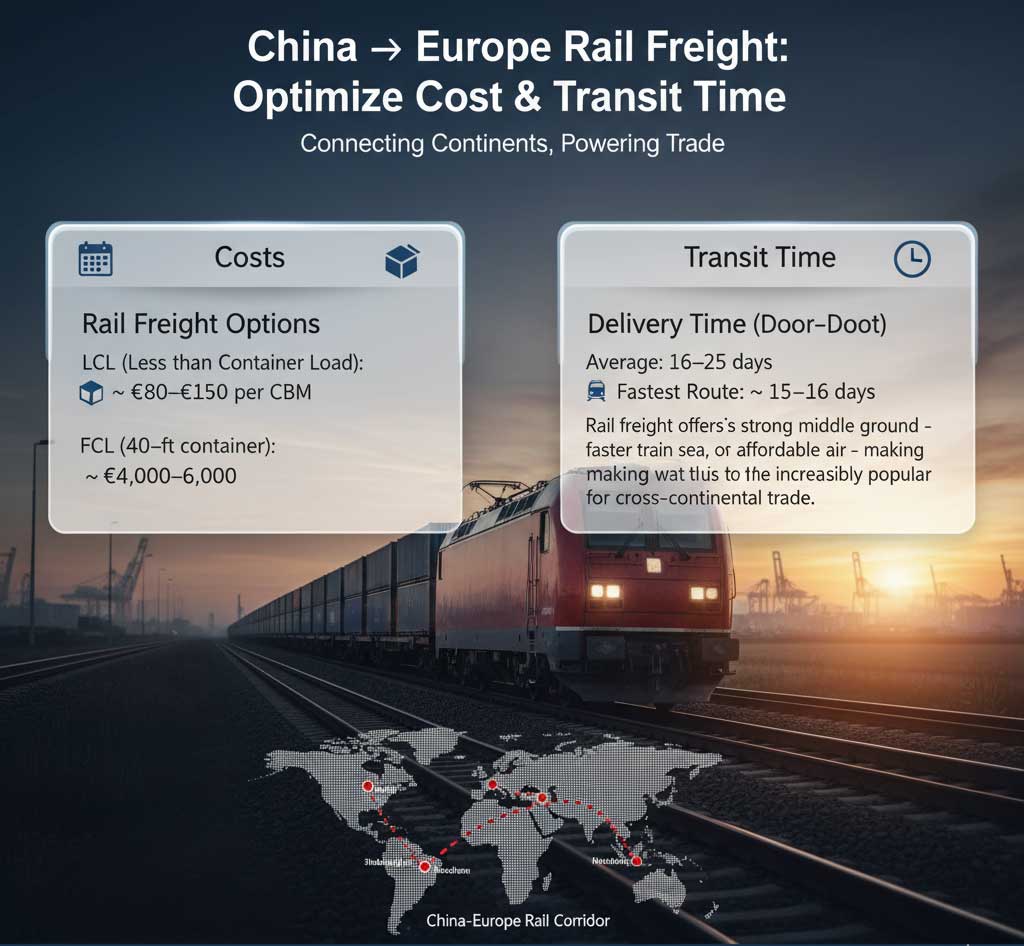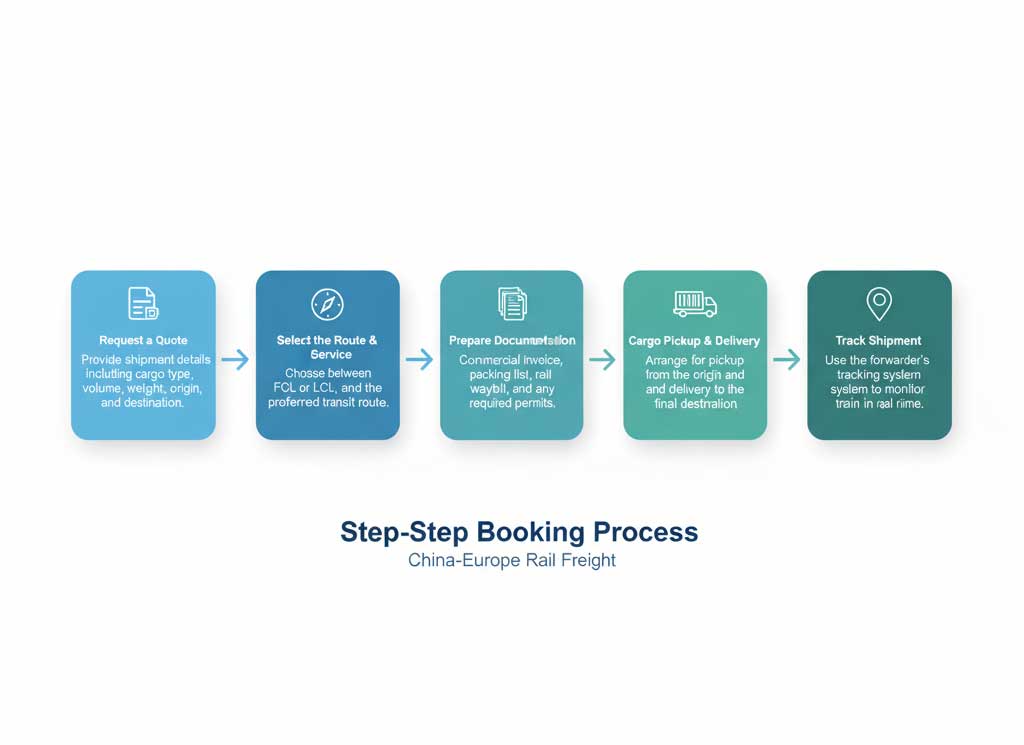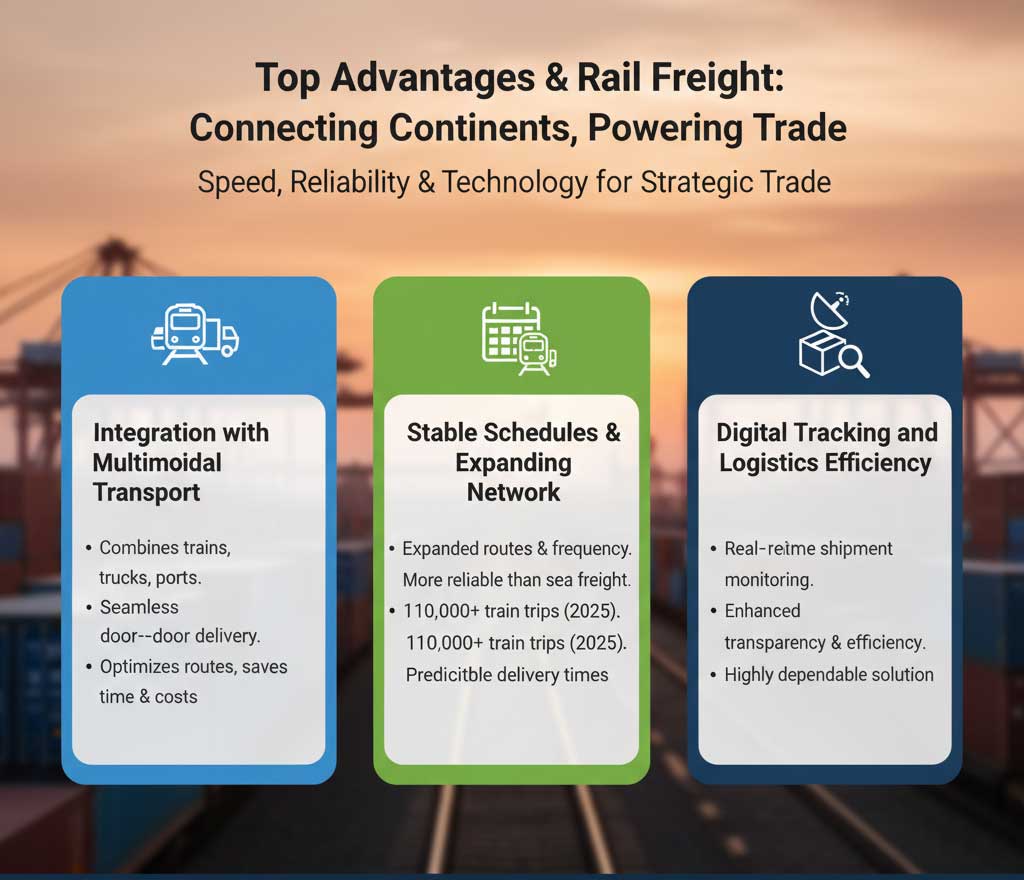In 2025, the China Europe rail network reached a major milestone: over 110,000 freight train trips have been completed, transporting goods worth more than US $450 billion.
Rail freight is not only growing rapidly but also redefining the future of Eurasian trade. Businesses increasingly rely on shipping from China to Europe via rail as a cost effective and reliable alternative to air and sea transport.

Cost & Transit Time: China → Europe (Rail Freight)
- LCL (Less than Container Load): ~ €80–€150 per CBM
- FCL (40-ft container): ~ €4,000–€6,000
- Transit times (door-to-door): 16–25 days on average
- Fastest observed route: ~ 15–16 days (e.g. Yiwu–Duisburg)
Rail freight offers a strong middle ground faster than sea, more affordable than air making it increasingly popular for cross-continental trade.
Introduction
Trade between China and Europe has expanded rapidly, creating a growing demand for efficient transport solutions. Rail freight from China to Europe offers a perfect balance between air and sea shipping faster than sea, cheaper than air. Main routes like the China Europe Railway Express connect key cities such as Chongqing, Xi’an, and Yiwu to major European hubs like Duisburg and Warsaw.
With shorter transit times and reliable schedules, rail transport is becoming a smart choice for global traders. In this article, we’ll explore how the China Europe rail network works, the main routes, transit times, costs, and the key advantages for importers and exporters. Keep reading to find out why rail freight is becoming one of the most efficient ways to move goods between China and Europe.
What Is Rail Freight from China to Europe?
Definition and Concept of Rail Freight
Rail freight from China to Europe refers to the transportation of goods by train across Eurasia, offering a middle ground between air and sea shipping.
It combines the reliability and capacity of traditional freight transport with faster transit times, making it a preferred option for businesses that need both efficiency and cost control.
How the China Europe Railway Express Works
The China Europe Railway Express is a network of rail routes that connect major Chinese cities like Yiwu, Chongqing, and Xi’an to European destinations such as Duisburg, Warsaw, and Madrid. Trains pass through countries including Kazakhstan, Russia, Belarus, and Poland before reaching their European endpoints. This system operates on a “block train” model dedicated trains that run directly between origin and destination without unnecessary stops, reducing delays and ensuring predictable delivery times.
Key Trade Routes
Several main corridors form the backbone of the China Europe rail network:
- Yiwu Madrid Route: One of the longest freight routes in the world, covering about 13,000 km across eight countries.
- Chongqing Duisburg Route: A major connection for electronics and machinery, linking central China to Germany’s industrial heart.
- Zhengzhou Hamburg Route: Known for its balanced trade flow, supporting both imports and exports between China and Europe.
These routes play a vital role in strengthening economic ties and providing businesses with faster, greener, and more predictable transport solutions across continents.
Why Choose Rail Freight from China to Europe?

Faster than Sea Freight, Cheaper than Air Freight
Rail freight from China to Europe offers the perfect balance of speed and cost. While sea freight can take up to 40–50 days, trains deliver goods in just 16–25 days on average. It’s also 60–70% cheaper than air freight, making it an ideal option for businesses that value both efficiency and affordability.
Environmentally Friendly Option
Rail transport is a greener alternative to air and sea shipping. It produces up to 80% less CO₂ emissions compared to air freight and consumes less fuel per ton of cargo. Choosing rail freight helps companies reduce their carbon footprint while supporting sustainable global trade.
High Reliability and Safety
With stable schedules and advanced tracking systems, rail freight between China and Europe ensures timely and secure delivery.
Trains operate on fixed timetables with fewer delays caused by weather or port congestion, providing businesses with greater supply chain stability and shipment visibility.
Suitable for Medium and High Value Goods
Rail freight is ideal for goods that require faster delivery than sea freight but don’t justify the high cost of air. Common shipments include electronics, automotive parts, machinery, fashion items, and industrial equipment. Its balance of speed, cost, and reliability makes it a smart logistics solution for medium to high value cargo.
Main Rail Routes and Transit Time
Overview of Major Terminals and Routes
The China Europe rail network connects major Chinese hubs to key European cities through several established corridors:
- Yiwu Madrid: Covers around 13,000 km across eight countries, mainly carrying consumer goods.
- Chongqing Duisburg: A key route for electronics, machinery, and industrial products.
- Zhengzhou Hamburg: Supports balanced trade, connecting China’s central regions with Germany’s northern ports.
Other important terminals include Xi’an, Wuhan, and Hefei, linking to destinations like Warsaw, Milan, and Lodz in Europe. These routes ensure broad coverage and efficient cargo movement across Eurasia.
Average Transit Time from China to Key European Cities
- Yiwu Madrid: ~21–25 days
- Chongqing Duisburg: ~16–18 days
- Zhengzhou Hamburg: ~18–20 days
Transit times can vary slightly depending on customs clearance, route congestion, and seasonal demand, but trains generally provide faster delivery than sea freight while remaining cost effective.
Factors That Affect Delivery Time
Several elements can influence transit times for rail freight:
- Customs procedures at borders and European ports
- Route selection and number of stops along the corridor
- Seasonal demand and train frequency
- Cargo type and handling requirements
Best Incoterms for Rail Freight from China to Europe
When shipping goods from China to Europe by rail, understanding the right Incoterms can help you save money, manage risk, and ensure smooth delivery. Below are the best Incoterms for rail freight from China to Europe, each offering different levels of control and responsibility.
FCA (Free Carrier): Ideal for rail shipments from China to Europe
Under FCA, the seller delivers the goods cleared for export to a carrier or terminal nominated by the buyer in China. Once the goods are handed over, the buyer assumes all risks and costs for the journey to Europe.
This Incoterm is perfect for rail freight because it provides buyers with flexibility to choose their preferred European route, destination terminal, and logistics provider.
Best for: Buyers in Europe who want full control over their rail logistics and costs.
CPT (Carriage Paid To): When sellers pay for freight but buyers handle insurance
With CPT, the seller pays for the rail freight from China to the agreed destination in Europe. However, risk transfers to the buyer as soon as the goods are handed to the carrier in China.
This arrangement is simple and efficient, making it ideal for regular shipments to major European hubs like Hamburg, Warsaw, or Duisburg.
Best for: Companies in Europe looking for predictable freight costs and simple coordination.
CIP (Carriage and Insurance Paid To): Ensures added security for valuable goods
The CIP term is similar to CPT, but the seller must also provide insurance coverage for the goods during transit. This makes it ideal for valuable or sensitive cargo traveling on rail routes between China and Europe.
CIP gives peace of mind to European importers who want added protection against transit damage or loss.
Best for: Importers in Europe shipping high-value items such as electronics, machinery, or medical equipment.
DAP (Delivered at Place): Smooth delivery to European destinations including the UK
Under DAP, the seller manages almost the entire rail transport process delivering the goods directly to the buyer’s chosen location in Europe, such as a warehouse or rail terminal. The buyer is only responsible for customs clearance and import taxes at the destination.
It’s a preferred choice for companies that want door-to-door rail delivery from China to Europe without logistical complexity.
Best for: European businesses seeking reliable and simplified delivery solutions.
DDP (Delivered Duty Paid): Full-service shipping for buyers in Europe
DDP is the most buyer-friendly Incoterm for rail freight from China to Europe. The seller handles everything including freight, customs clearance, and import duties until the goods reach the buyer’s door.
It’s an all inclusive solution that eliminates administrative work for the buyer, ensuring seamless delivery across European countries such as Germany, France, Poland, and the UK.
Best for: Buyers in Europe who want a completely managed, worry-free shipping process.
Rail Freight Costs from China to Europe
How Rail Freight Rates Are Calculated?
Rail freight rates from China to Europe depend on several key factors.
The most important ones include:
- Distance and Route: Costs vary depending on the departure and destination cities. Routes from major Chinese hubs like Chongqing, Xi’an, or Chengdu to European destinations such as Duisburg, Hamburg, or London may differ slightly in price due to track length and transit infrastructure.
- Container Type: Full Container Load (FCL) shipments generally cost less per unit than Less than Container Load (LCL) shipments because the entire container is booked by one consignee.
- Weight and Volume: Heavier or oversized cargo incurs higher costs due to space and handling limitations.
- Customs and Handling Fees: Charges may apply at borders, especially for multimodal routes that cross several countries.
- Season and Demand: Rates fluctuate during peak seasons, such as before Chinese New Year or the European holiday period.
Overall, rail freight pricing is designed to offer predictable, mid-range logistics costs with faster delivery than ocean freight and far lower prices than air freight.
Cost Comparison: Rail vs Air vs Sea

To understand the value of rail freight, it helps to compare it directly with air and sea transport:
| Mode of Transport | Average Transit Time | Average Cost (per 40ft container) | Ideal for |
|---|---|---|---|
| Air Freight | 5–10 days | $10,000–$20,000 | Urgent or high-value goods |
| Rail Freight | 15–20 days | $6,000–$9,000 | Medium-value, time-sensitive cargo |
| Sea Freight | 30–45 days | $2,000–$4,000 | Bulk or low-value goods |
As shown, rail freight offers a balanced solution. It is 60–70% cheaper than air freight and 50% faster than sea freight, making it an ideal option for companies looking for both cost savings and reliable transit times.
Examples of Average Shipping Prices per Container
Below are some general examples of rail freight costs from major Chinese cities to European destinations (approximate rates as of 2025):
| Route | FCL (40ft) | LCL (per CBM) | Transit Time |
|---|---|---|---|
| Xi’an → Duisburg (Germany) | $7,000 | $150–$200 | 16–18 days |
| Chongqing → Warsaw (Poland) | $6,800 | $140–$180 | 15–17 days |
| Chengdu → London (UK) | $8,500 | $180–$220 | 18–20 days |
| Zhengzhou → Milan (Italy) | $7,200 | $160–$190 | 17–19 days |
These prices can vary depending on market demand, rail operator, and local customs policies. Many freight forwarders specializing in shipping from China to UK also provide door to door rail freight services, including customs clearance and last-mile delivery within the UK or EU.
For precise volume-based pricing, you can easily calculate your cargo’s dimensions and weight using our Cubic Calculator.
Customs and Documentation for China Europe Rail Freight
Import & Export Requirements
Shipping goods by rail from China to Europe requires compliance with both countries’ trade regulations. Key requirements include:
- Commercial invoice and packing list
- Bill of lading or rail waybill
- Certificates of origin or product-specific permits
- Compliance with EU import rules such as tariffs, VAT, and restricted goods lists
Proper preparation ensures smoother transit and avoids delays at borders.
Customs Clearance Process
Rail freight passes through multiple countries, so customs clearance occurs at key checkpoints along the route.
Steps typically include:
- Submission of documentation to rail operator or customs broker
- Inspection of goods and verification of compliance
- Payment of duties, taxes, and any applicable fees
- Release of cargo for onward transport to the final destination
Using experienced freight forwarders can simplify the process and reduce the risk of delays.
Common Mistakes to Avoid
- Incomplete or inaccurate documentation
- Misdeclaring the type, value, or quantity of goods
- Ignoring specific EU or transit country regulations
- Failing to plan for customs clearance time in transit schedules
Careful preparation and professional support are essential for hassle-free rail freight between China and Europe.
What Can You Ship by Rail Freight?
| Category | Details / Examples |
|---|---|
| Common Goods Transported via Rail | Electronics, machinery, industrial equipment, fashion & textiles, automotive parts, e-commerce & retail products |
| Restricted and Prohibited Items | Hazardous chemicals, flammable materials, explosives, weapons, perishable goods with strict temperature control, items restricted by EU or transit countries |
| Ideal Cargo Types for Rail Shipping | Medium- to high-value goods, non-perishable products, shipments where cost-efficiency and reliable delivery are priorities over ultra-fast transit |
How to Book Rail Freight from China to Europe?
Choosing a Reliable Freight Forwarder
Selecting an experienced freight forwarder is crucial for smooth rail shipments. Look for providers that offer:
- Established China Europe rail network connections
- Full-service support (documentation, customs clearance, insurance)
- Transparent pricing and transit time estimates
- Tracking and customer service throughout the journey
- A trustworthy forwarder helps reduce risks and ensures your goods arrive safely and on time.

Step-by-Step Booking Process
- Request a Quote: Provide shipment details including cargo type, volume, weight, origin, and destination.
- Select the Route & Service: Choose between FCL or LCL, and the preferred transit route.
- Prepare Documentation: Commercial invoice, packing list, rail waybill, and any required permits.
- Cargo Pickup & Delivery: Arrange for pickup from the origin and delivery to the final destination.
- Track Shipment: Use the forwarder’s tracking system to monitor the train in real time.
Tips for First Time Shippers
- Plan ahead and account for customs clearance time.
- Verify all documentation to prevent delays.
- Use a freight forwarder experienced in China Europe rail routes.
- Start with smaller shipments to understand transit times and procedures.
By following these steps, businesses can confidently use rail freight from China to Europe for cost-effective and reliable shipping.
Top Advantages of Rail Freight in 2025

Integration with Multimodal Transport
In 2025, rail freight from China to Europe is increasingly integrated with multimodal transport, combining trains, trucks, and ports for seamless door to door delivery. This allows businesses to optimize routes, reduce handling, and save time and costs across the supply chain.
Stable Schedules and Expanding Network
The China Europe rail network continues to expand its routes and frequency, offering more reliable schedules than sea freight. With over 110,000 train trips in 2025, companies can plan shipments with predictable delivery times and fewer delays caused by congestion or weather.
Digital Tracking and Improved Logistics Efficiency
Advanced digital tracking systems enable real time monitoring of shipments, improving transparency and efficiency. Shippers can track goods at every stage, anticipate delays, and streamline customs clearance, making rail freight a highly dependable solution for modern trade.
Rail freight in 2025 combines speed, reliability, and technology, making it a strategic choice for businesses trading between China and Europe.
Challenges and Limitations of Rail Freight

Limited Capacity During Peak Season
During high demand periods, especially before holidays like Chinese New Year or European sales seasons, rail freight capacity can be limited. This may lead to higher costs or longer waiting times for available trains.
Customs Delays and Route Changes
Rail freight passes through multiple countries, making customs clearance a critical factor. Unexpected inspections, documentation errors, or geopolitical issues can cause delays. Additionally, route adjustments may be required due to rail congestion or infrastructure changes.
Temperature and Cargo Restrictions
Rail freight is generally suitable for non-perishable goods, machinery, electronics, and textiles. However, it may not be ideal for products requiring strict temperature control, high humidity protection, or hazardous materials, which are either restricted or need special permits.
Despite these limitations, rail freight remains a fast, cost-effective, and reliable option for many businesses trading between China and Europe.
Rail Freight vs Air and Sea Shipping: Which Is Best for You?
| Transport Mode | Average Transit Time | Cost | Reliability | Best For |
|---|---|---|---|---|
| Rail Freight | 16–25 days | Moderate (€4,000–€6,000 per 40ft FCL) | High | Medium- to high-value goods needing faster delivery than sea freight |
| Air Freight | 3–7 days | High | Very High | Urgent or lightweight shipments where speed is critical |
| Sea Freight | 35–50 days | Low | Moderate | Large-volume, low-cost shipments where delivery time is flexible |
Best Scenarios for Each Transport Mode
- Rail Freight: Ideal for businesses that need a balance of speed, cost, and reliability. Perfect for electronics, machinery, and consumer goods.
- Air Freight: Best for urgent deliveries, high-value or fragile items that cannot wait for sea or rail transit.
- Sea Freight: Suitable for heavy, bulk cargo with flexible schedules where cost efficiency is the priority.
RealWorld Examples
- A European retailer imports consumer electronics from Yiwu to Duisburg using rail, saving half the transit time of sea freight at a fraction of air freight costs.
- An automotive parts supplier ships urgent components from Shanghai to Frankfurt by air to meet production deadlines.
- A manufacturer moves bulk textiles from Guangzhou to Rotterdam via sea, benefiting from lower shipping costs for large volumes.
By evaluating speed, cost, and reliability, businesses can choose the transport mode that best fits their supply chain needs.
How Topshipping Helps with Rail Freight from China to Europe
Complete Rail Freight Solutions (FCL/LCL)
Topshipping provides full-service rail freight solutions for both Full Container Load (FCL) and Less than Container Load (LCL) shipments.
Whether you’re shipping large volumes or smaller batches, Topshipping ensures efficient cargo consolidation, competitive pricing, and reliable transit from origin to destination.
Door-to-Door Service and Customs Support
With Topshipping, you benefit from door to door delivery, handling all logistics from your supplier in China to your warehouse in Europe. Their team also manages customs documentation and clearance, reducing delays and simplifying compliance with international trade regulations.
Why Choose Topshipping as Your Freight Forwarder
Topshipping stands out for:
- Extensive China Europe rail network experience
- Transparent pricing and clear transit time estimates
- Real-time shipment tracking and updates
- Personalized support for first-time shippers and large enterprises alike
By choosing Topshipping, businesses can optimize their supply chain, save costs, and ensure that rail freight shipments arrive on time and in perfect condition.
Final Review: The Future of China Europe Rail Freight
The China Europe rail network has grown rapidly thanks to its unique mix of speed, cost efficiency, reliability, and environmental benefits.
Rail freight provides a strong alternative to sea and air transport, making it ideal for medium to high value goods that need predictable transit times.
Today, China Europe rail shipping routes continue to expand with new corridors, more frequent trains, and advanced digital tracking systems ensuring faster and more efficient trade between the two continents.
For businesses aiming to optimize logistics and reduce shipping costs, rail freight is a strategic and sustainable solution. Contact Topshipping today to plan your first China Europe rail shipment and experience reliable, fast, and cost effective freight services.
FAQs about Rail Freight from China to Europe
Q1: How long does rail freight take from China to Europe?
A: Average transit time is 16–25 days door to door, depending on the route and customs clearance. The fastest routes, like Yiwu Duisburg, can take around 15–16 days.
Q2: What are the main rail freight routes?
A: Key routes include:
- Yiwu Madrid (consumer goods)
- Chongqing Duisburg (electronics & machinery)
- Zhengzhou Hamburg (balanced trade flow)
Other important hubs include Xi’an, Wuhan, and Hefei connecting to major European cities like Warsaw, Milan, and Lodz.
Q3: Is rail freight cheaper than air freight?
A: Yes. Rail freight is much cheaper than air freight (typically €4,000–€6,000 per 40ft FCL) while offering faster delivery than sea shipping. It’s ideal for medium- to high-value goods that don’t require urgent air transport.
Q4: Can I track my rail shipment online?
A: Absolutely. Most freight forwarders, including Topshipping, provide real-time tracking so you can monitor your cargo at every stage, ensuring transparency and peace of mind.


